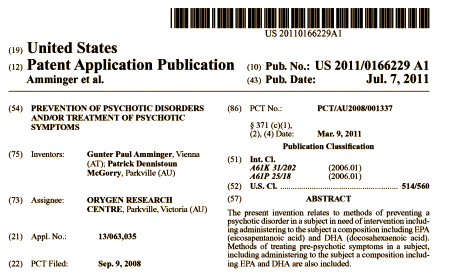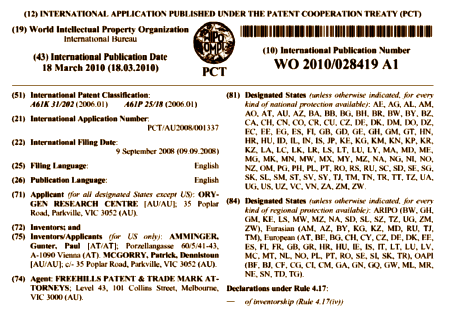| As best I can tell, a Corrigendum is an error that gets corrected in a later edition or article. Corrigendum is a brand new word for me, and it doesn’t yet just roll off the tongue. I think it’s publication-ese for "whoops" – not a way to cover up for previous deceit but rather to correct late-found errors. In my case, it’s to try to clear up my own ignorance of how things like patents work. This post is called Corrigendum I because I don’t yet feel totally clear myself, but I don’t know a word for "Corrigendum in progress," so I’ll just number them to mark any improvements in clarity I might muster along the way. |
Last week, I reported on a US patent application filed by Gunter Paul Amminger and Patrick McGorry for using ω-3 Fatty Acids to prevent or treat psychosis [the appearance of a conflict of interest…]:

Since then, I’ve obtained a copy of the International Patent Application filed on the same date:

It lists the Orygen Research Centre as the applicant for all designated States except US and the inventors [Amminger and McGorry] as applicants for US only. It is my assumption that this means that the US patent will be owned by Drs. Amminger and McGorry, and the patent in the rest of the world will belong to the Orygen Research Centre. It obviously matters in terms of who receives the financial rewards of patent ownership.
The Orygen Research Centre is an non-profit partnered with the University of Melbourne and the Colonial Foundation. Dr. McGorry is the Executive Director. EPPIC [Early Psychosis Prevention and Intervention Program] is a program of Orygen Youth Health, funded by the Victorian Department of Human Services, and is affiliated with other organisations working with young people in early intervention. How all of these organizations sew together is not at all clear to me at this point.
The EPPIC program is operated within the non-profit Orygen with an apparent influx of heavy funding from the Australian government. The use of the ω-3 Fatty Acids is frequently mentioned as a component of these early intervention strategies. So applying for a patent for ω-3 Fatty Acids seems like personal entrepreneurism as a part of a public and non-profit endeavor. In addition, it’s an obvious conflict of interest extraordinaire to be studying and/or using a drug that you’ve applied to patent in a program that you direct. Certainly, something like that ought to be declared up front in any activity that has to do with the enterprise.
So, back to the Corrigendum part. In my last post, I became hopelessly muddled about the timeline [the appearance of a conflict of interest…]. I understand the source of my confusion better now. The article in the Archives of General Psychiatry [Long-Chain ω-3 Fatty Acids for Indicated Prevention of Psychotic Disorders] that demonstrated their efficacy had these stats:
| Submitted for Publication: | Dec 18, 2008 |
| Final Revision received: | May 26, 2009 |
| Accepted for Publication: | May 27, 2009 |
| Publication Date: | February 2010 |
| Financial Disclosure: | None reported |
| Trial Registration [clinicaltrials.gov]: | NCT00396643 |
There was another more recent [very similar] clinical trial [NEUROPRO-E] registered in the Australian New Zealand Clinical Trials Registry. It’s stats:
| Trial Registration [anzctr.org]: | ACTRN12608000475347 |
| Trial Submitted: | Sep 1, 2008 |
| Trial Registered: | Sep 28, 2008 |
| Ethics Committee Approval: | Jan 28, 2009 |
| Trial Last Updated: | Aug 3, 2011 |
So I had been confused. These were two separate trials. However, the question of conflict of interest declaration remains. The patent was submitted on September 9, 2008 after the trial for the Archives of General Psychiatry article was completed. So the question is, did Dr. McGorry declare the Patent Application to the Melbourne Health Human Research Ethics Committee prior to their January 28, 2009 approval of the new trial? It’s not mentioned on the website.
In the US, the natural person that is the inventor has to apply for the patent. Inventors can then assign the patent to their employer (or any other person). Outside the US, the employer (assignee) can apply for the patent. This actually does not present any conflict of interest.
Mark,
Thanks for that. See my next post…
Kimmelman et al. (2007) provide a good analysis of institutional COI and the need for disclosure before patents are granted:
‘patents authorized by the Bayh-Dole Act also create institutional conflicting interests; these should be managed in a manner that parallels those for investigators. Namely, a categorical disallowance of institutions from hosting trials on agents for which they hold patents would be unwise, because such institutions may have the most suitable facilities and expertise for conducting these trials. However, institutional, patent-related conflicting interests should be subjected to independent review and presumptively disclosed to research subjects. To avoid concerns that an IRB might internalize its institution’s aspirations for prestige and financial flourishing, a committee external to the institution should conduct review. …. Fourth, investigators should always disclose to subjects and IRBs that they have filed for a patent, even if the patent has not yet been received.
Although this extends conflict of interest management into realms where financial interests are incipient, oversight of commercial intention is not unprecedented. Concerned about ensuring “as full communication as possible among investigators and clinicians concerning research methods and results”-RAC, for example-invites investigators to disclose patenting intentions. Similarly, as shown in Table 3, many journals ask authors about patent intentions.’
Kimmelman J. Inventors as investigators: the ethics of patents in clinical trials. Acad Med. 2007 Jan;82(1):24-31.
http://www.ncbi.nlm.nih.gov/pubmed/17198287
Melissa,
Thanks to you as well. It’s a well-thought out and reasoned article. See Corrigendum III…